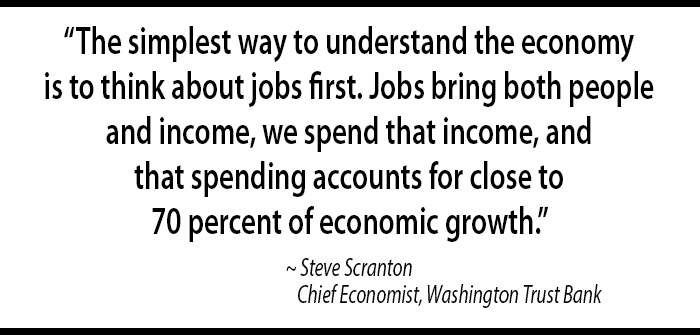Cascade Business News had the opportunity to sit down with Steve Scranton, chief economist for Washington Trust Bank. Scranton holds a Chartered Financial Analyst designation with over 40 years of investment and economic experience. In Scranton’s role as the chief economist for Washington Trust Bank, he participates in public speaking engagements, as well as authoring multiple communications, to keep clients and the public informed of economic and investment market conditions. Throughout the Pacific Northwest, Scranton is a well-known speaker on economic conditions, and has some key insight into the economic conditions that Bend is currently facing.
One of the main trends Scranton sees in Bend can be seen around the nation; Bend’s economy has grown as a result of a large influx of population in Central Oregon, especially from tech companies and workers moving to town.
“The simplest way to understand the economy is to think about jobs first,” Scranton said. “Jobs bring both people and income, we spend that income, and that spending accounts for close to 70 percent of economic growth.”
Bend has historically seen strong job growth for decades, even when other states and even other cities in Oregon were not. However, based on data from this last June, that growth is slowing down. The most recent data shows Bend’s job growth at .2 percent year-over-year (YOY), compared to last year’s 1.7 percent. Still, that is better than Oregon’s job growth, which sits at 0 percent, and Portland’s job growth, which sits at -.7 percent.
Scranton pointed out that this decline of growth in Bend is likely due to three industries.
“This last year saw construction saw job growth fall by 4.8 percent, manufacturing fell by 3.1 percent, and the tech industry saw a fall of 5.6 percent,” Scranton said. “These are notably all negative.”
For the tech industry, Scranton mentioned how shifting economic conditions can be difficult for remote workers, which the local tech industry is well known for. When a company lays off employees, they almost always start with remote workers. As a remote worker in Bend in the tech industry, it can be very difficult to find another position, as there simply are not many tech jobs in Bend’s economy; many tech jobs operate remotely, working for companies in larger markets like Seattle, for example.
If a tech worker, who works for a Seattle company, gets laid off, it might be more beneficial for them to move back home, as opposed to trying to find a local tech position, which would most likely give them a pay decrease. In addition, the rising cost of living and home prices make it difficult for workers across all industries to stay in Bend.
That’s an easy way to explain the decline in construction and manufacturing jobs; if people can’t afford homes, the jobs based around building homes will decline as the demand keeps decreasing.
However, Bend has seen growth in the core sector of education and healthcare, as well as hospitality; 4.3 percent YOY and 3.2 percent YOY, respectively. Other areas like mechanics, yard care, services, and others are still remaining steady.
“As a tourist economy, people want to experience Bend,” Scranton said. “People are still coming and relying on these hospitality and service industry workers. We are creating jobs there, but still losing higher paying jobs, like tech.”
Scranton spoke on how losing higher paying jobs, like in tech, can contribute to a decline in other industries, “Construction was strong, but rising home prices, rising costs of labor and rising material prices make it so people can’t afford to buy, thus decreasing the demand for homes and further declining the construction industry, especially when Bend is losing higher paying jobs. With fewer people who can afford a home here, the demand for homes will keep decreasing as workers opt to buy and own somewhere they can afford.”
However, we have grown overall. Bend saw 3.5 percent total labor growth YOY, compared to the national average of .6 percent. Scranton attributes this to many people moving to Bend, and many young locals choosing not to move away.
“That’s a good sign because businesses still need that labor pool, and the market to support it,” Scranton said.
The biggest concern on Scranton’s mind for the Bend economy? Home prices.
“Looking at zillow, the media price is almost $745,000, which is a 4 percent increase from the year before. As the younger population stays in Bend, they want to buy houses. But, this is very difficult when we look at the comparison between median home price and income.”
Continuing, Scranton said, “If I take that median price and assume a ten percent down payment at current interest rates of seven percent, what percent of the average worker’s paycheck is eaten up? It should be 30-40 percent. In Oregon, it’s average 56 percent. For Bend, it’s 91 percent.”
Scranton said that stakeholders need to come together to solve this problem, otherwise we may see further economic issues caused by a decrease in our workforce, a decline in the service/hospitality industries, and as a result, businesses leaving Bend in favor of markets they can both succeed in, and maintain their workforce.
In an odd way, Bend is suffering from success. An increase in property value and high paying jobs looks great, and is great for many people, but without balancing the economy to make Bend a realist place to live and own a home for the average worker, those higher paying jobs and nice houses contribute to the reality for the average worker; that Bend is becoming unlivable, and they may be forced to move away.
Scranton recommends coming together to solve this issue and create infrastructure that can sustain realistic growth that benefits the Bend economy, like roads, schools, and housing that the average worker can afford.
In addition, he recommends listening to your local buyers, “Cities might benefit from allowing smaller, more efficient dwellings as opposed to single family home lots. The younger generation wants to own and build equity, and workers don’t want to live two hours from work just to own a home. Some places try to increase density with four or six plexes, but that doesn’t benefit the renters in the long term. They want something small to make their own and build equity.”
Scranton sees a positive future, where stakeholders in these industries come together to make Bend and our economy work for everyone.





